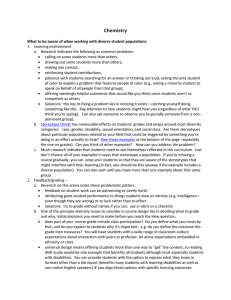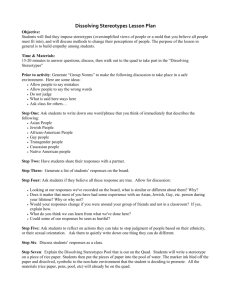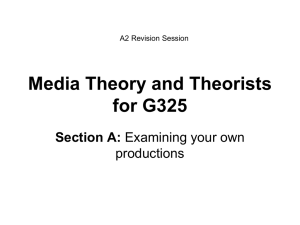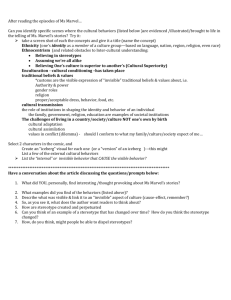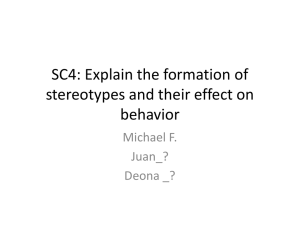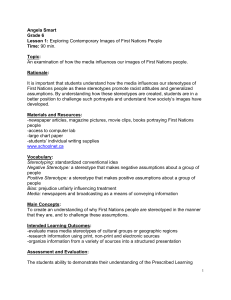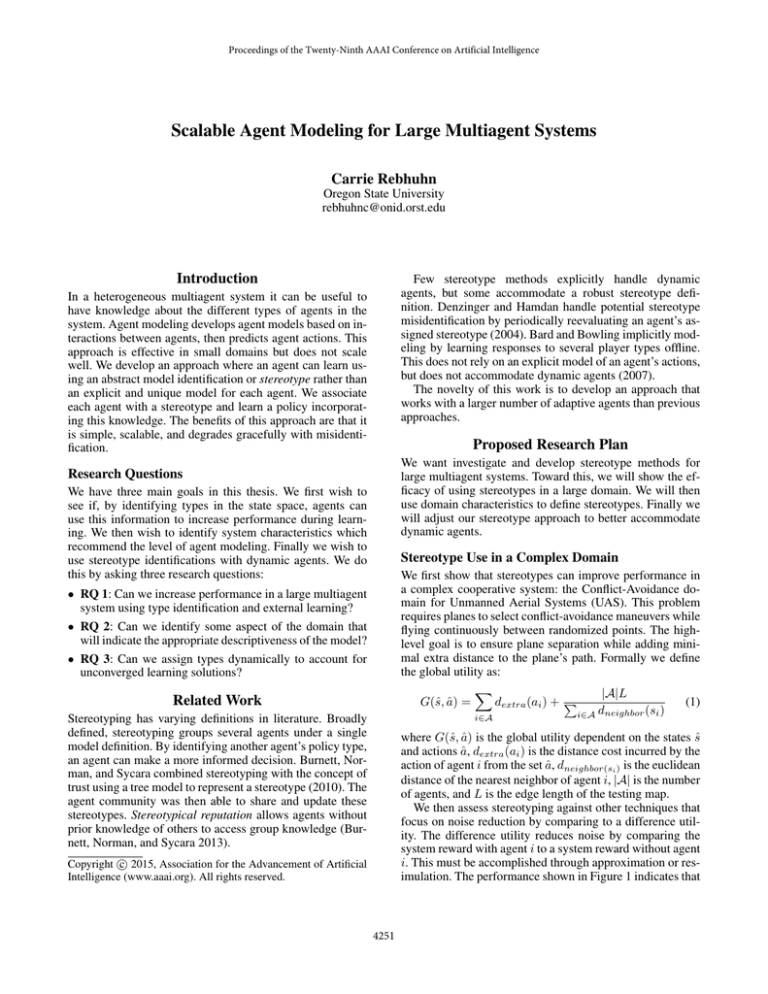
Proceedings of the Twenty-Ninth AAAI Conference on Artificial Intelligence
Scalable Agent Modeling for Large Multiagent Systems
Carrie Rebhuhn
Oregon State University
rebhuhnc@onid.orst.edu
Introduction
Few stereotype methods explicitly handle dynamic
agents, but some accommodate a robust stereotype definition. Denzinger and Hamdan handle potential stereotype
misidentification by periodically reevaluating an agent’s assigned stereotype (2004). Bard and Bowling implicitly modeling by learning responses to several player types offline.
This does not rely on an explicit model of an agent’s actions,
but does not accommodate dynamic agents (2007).
The novelty of this work is to develop an approach that
works with a larger number of adaptive agents than previous
approaches.
In a heterogeneous multiagent system it can be useful to
have knowledge about the different types of agents in the
system. Agent modeling develops agent models based on interactions between agents, then predicts agent actions. This
approach is effective in small domains but does not scale
well. We develop an approach where an agent can learn using an abstract model identification or stereotype rather than
an explicit and unique model for each agent. We associate
each agent with a stereotype and learn a policy incorporating this knowledge. The benefits of this approach are that it
is simple, scalable, and degrades gracefully with misidentification.
Proposed Research Plan
We want investigate and develop stereotype methods for
large multiagent systems. Toward this, we will show the efficacy of using stereotypes in a large domain. We will then
use domain characteristics to define stereotypes. Finally we
will adjust our stereotype approach to better accommodate
dynamic agents.
Research Questions
We have three main goals in this thesis. We first wish to
see if, by identifying types in the state space, agents can
use this information to increase performance during learning. We then wish to identify system characteristics which
recommend the level of agent modeling. Finally we wish to
use stereotype identifications with dynamic agents. We do
this by asking three research questions:
Stereotype Use in a Complex Domain
We first show that stereotypes can improve performance in
a complex cooperative system: the Conflict-Avoidance domain for Unmanned Aerial Systems (UAS). This problem
requires planes to select conflict-avoidance maneuvers while
flying continuously between randomized points. The highlevel goal is to ensure plane separation while adding minimal extra distance to the plane’s path. Formally we define
the global utility as:
X
|A|L
G(ŝ, â) =
dextra (ai ) + P
(1)
i∈A dneighbor (si )
• RQ 1: Can we increase performance in a large multiagent
system using type identification and external learning?
• RQ 2: Can we identify some aspect of the domain that
will indicate the appropriate descriptiveness of the model?
• RQ 3: Can we assign types dynamically to account for
unconverged learning solutions?
Related Work
Stereotyping has varying definitions in literature. Broadly
defined, stereotyping groups several agents under a single
model definition. By identifying another agent’s policy type,
an agent can make a more informed decision. Burnett, Norman, and Sycara combined stereotyping with the concept of
trust using a tree model to represent a stereotype (2010). The
agent community was then able to share and update these
stereotypes. Stereotypical reputation allows agents without
prior knowledge of others to access group knowledge (Burnett, Norman, and Sycara 2013).
i∈A
where G(ŝ, â) is the global utility dependent on the states ŝ
and actions â, dextra (ai ) is the distance cost incurred by the
action of agent i from the set â, dneighbor(si ) is the euclidean
distance of the nearest neighbor of agent i, |A| is the number
of agents, and L is the edge length of the testing map.
We then assess stereotyping against other techniques that
focus on noise reduction by comparing to a difference utility. The difference utility reduces noise by comparing the
system reward with agent i to a system reward without agent
i. This must be accomplished through approximation or resimulation. The performance shown in Figure 1 indicates that
c 2015, Association for the Advancement of Artificial
Copyright Intelligence (www.aaai.org). All rights reserved.
4251
the inclusion of stereotypes is more effective than the difference utility at noise reduction in some cases. Using stereotypes requires no resimulation or approximations, which can
become computationally expensive. The full results and details for the UAS domain are available in the workshop paper
that appeared in ALA 2014 (Rebhuhn, Knudson, and Tumer
2014).
and we do not accommodate the changing demographic of
learners. Previous work has explored changes in stereotype
assignment, but this work re-estimates an agent’s assignment
to a set of fixed stereotypes (Denzinger and Hamdan 2004).
In a large learning system it may be more useful to adapt the
stereotype definition to remove stereotypes made obsolete
by the learning process.
Exploring the adaptation of stereotypes throughout the
learning run is important future work. In this work we will
focus on how to learn early on with stereotypes of unconverged agents. We will also explore how to incorporate
changing system demographics into the learning problem.
This will extend the applicability of stereotypes to more dynamic systems.
Conclusion
We show that we can gain advantages from the application of
stereotyping in cooperative domains. Future work remains
to identify a way to determine a model’s value to a system,
and to develop methods of handling changing models. With
these questions answered, we can construct a more accessible and structured application of stereotypes.
Figure 1: UAS domain comparison of minimizing global reward, global reward with stereotypes, and difference reward.
References
Bard, N., and Bowling, M. H. 2007. Particle filtering for
dynamic agent modelling in simplified poker. In Proceedings of the Twenty-Second AAAI Conference on Artificial Intelligence, July 22-26, 2007, Vancouver, British Columbia,
Canada, 515–521. AAAI Press.
Burnett, C.; Norman, T. J.; and Sycara, K. 2010. Bootstrapping trust evaluations through stereotypes. In Proceedings of
the 9th International Conference on Autonomous Agents and
Multiagent Systems: volume 1-Volume 1, 241–248. International Foundation for Autonomous Agents and Multiagent
Systems.
Burnett, C.; Norman, T. J.; and Sycara, K. 2013. Stereotypical trust and bias in dynamic multiagent systems. ACM
Transactions on Intelligent Systems and Technology (TIST)
4(2):26.
Denzinger, J., and Hamdan, J. 2004. Improving modeling of other agents using stereotypes and compactification of
observations. In 3rd International Joint Conference on Autonomous Agents and Multiagent Systems (AAMAS 2004),
19-23 August 2004, New York, NY, USA, 1414–1415. IEEE
Computer Society.
Rebhuhn, C.; Knudson, M.; and Tumer, K.
2014.
Announced strategy types in multiagent rl for conflictavoidance in the national airspace. In AAMAS-2014 Workshop on Adaptive and Learning Agents.
Developing Stereotype Metrics
In experiments with the UAS domain as well as smaller toy
experiments we have identified an important aspect of the
application of stereotypes; the stereotype information value.
If a stereotype does not add important information, it can
hinder the learning process by limiting the number of learning examples available. Differentiating between two agent
types may not be worth the cost of dividing the number of
learning examples. Conversely, making stereotype divisions
too coarse loses modeling gains because agent structure becomes environmental noise.
No prescriptive method currently exists for how to define
stereotypes to maximize the information of the stereotype.
We have already seen the effect of different levels of stereotype differentiation in toy experiments. From these experiments we will 1) define a metric that evaluates the information value given by the stereotype currently in use and 2) use
this metric to make appropriate stereotype divisions in a variety of problems. Work toward this should be completed or
in progress by January 2015.
Dynamic Stereotype Regeneration
Agents can use stereotypes to categorize fixed policies. An
agent that recognizes the pattern of another agent’s behavior can take an actions to accommodate this behavior. But
large multiagent systems often do not feature agents with
fixed policies. Because of this, a stereotyping method for a
large multiagent system must accommodate learning agents
as well as fixed or converged policies.
We have already included a ‘learner’ stereotype in the
UAS domain, which has an adapting policy. Yet, we do not
take advantage of patterns in learning throughout the run,
4252

